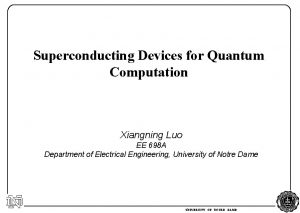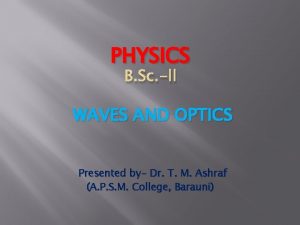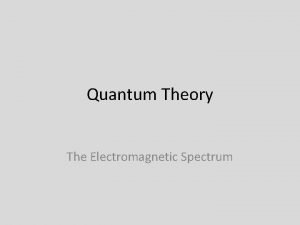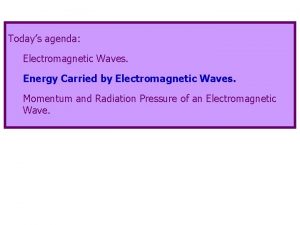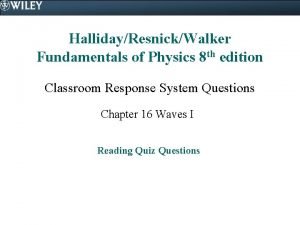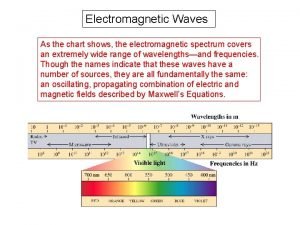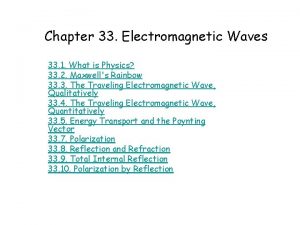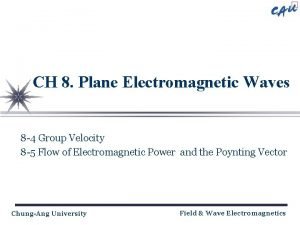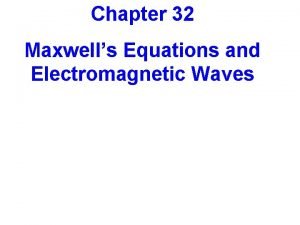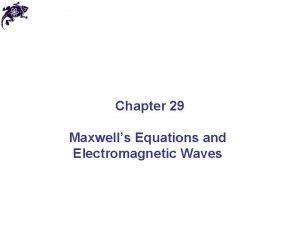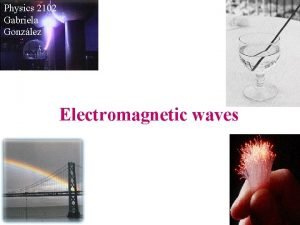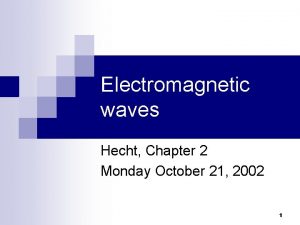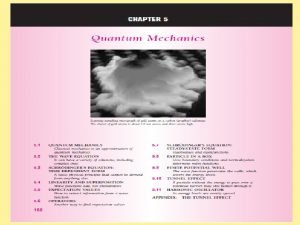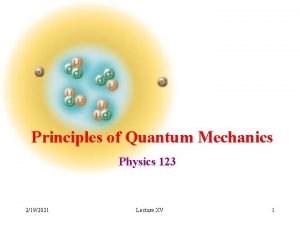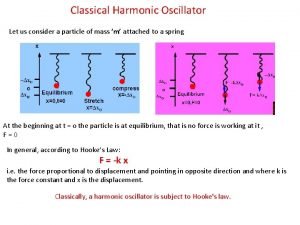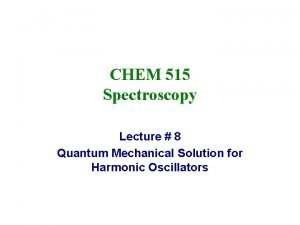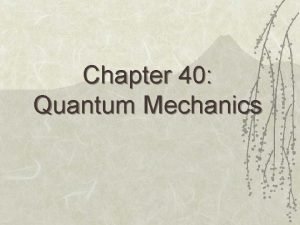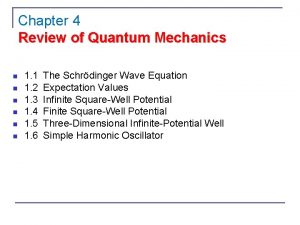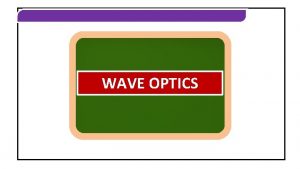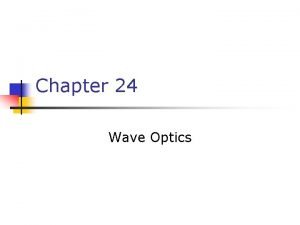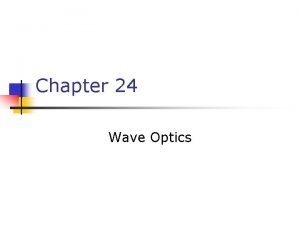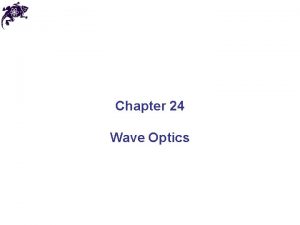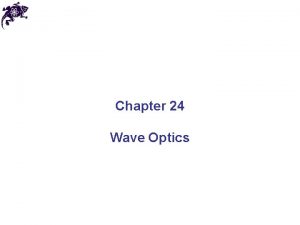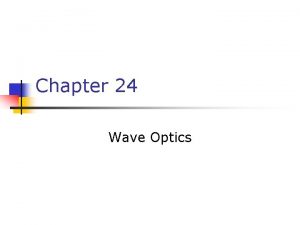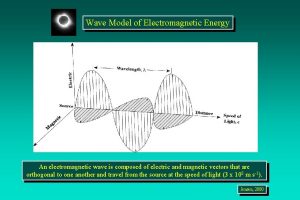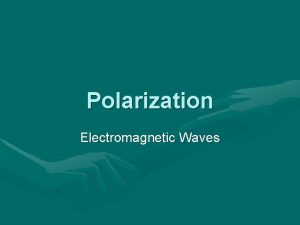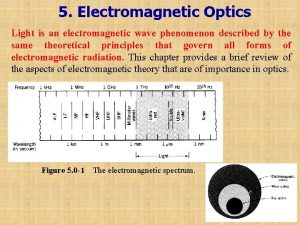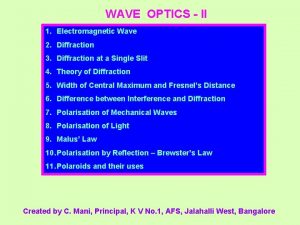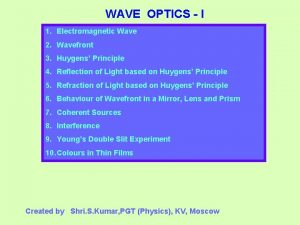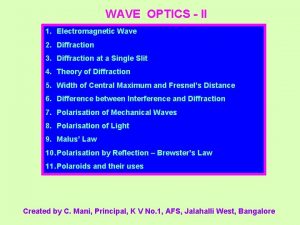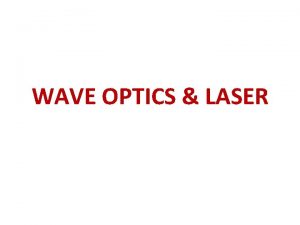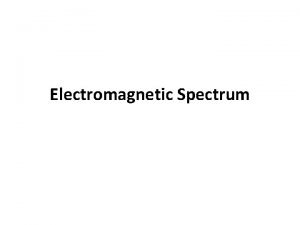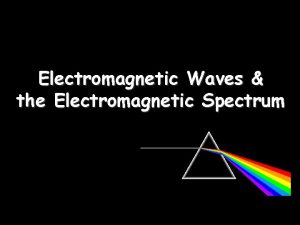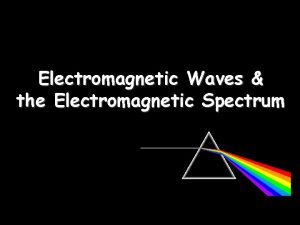1 Chapter 2 Wave Optics Quantum Optics Electromagnetic


































- Slides: 34

1

Chapter 2. Wave Optics Quantum Optics Electromagnetic Optics Wave Optics Ray Optics 2

3

When do we use Wave Optics? Lih Y. Lin, http: //www. ee. washington. edu/people/faculty/lin_lih/EE 485/ 4

Opt i c s regim es L E N S DE S I G N L IGHT DE S IGN PHOTON DE S I G N ( d >> λ ) ( d ~λ ) ( d << λ ) Geometrical Optics R a y tracing EM Wave O p t i c s Wave propagating Photonic s Photon tunneling (lens design) ( m eta l m a s t e r i n g ) (injection m o ldi n g ) (assembling) ( M T F monitoring) Wafer m as t e r i n g (embo s s i n g (packaging) ( e x t r a c t i o n effi) ( n a n o - t e c h ) Embedded mastering Nano imprinting (integrating) (quantum effi) Etendue ( ΔkxΔx)(ΔkxΔx)>1 Diff. L i m i t ( Δk x Δx > 1) U n c e r t ainty ( Δk x Δx > 1 ) L i g h t d e s ign (extraction) : LED field profile , polarization Quantum Optics Electromagnetic Optics Wave Optics L e n s de s i g n (projection) Photon design ( e - h combination) 5 Ray Optics

2 -1. Postulates of Wave Optics Wave Equation Intensity, Power, and Energy The optical energy (units of joules) collected in a given time interval is the time integral of the optical power over the time interval. 6

2. 2 MONOCHROMATICWAVES Complex representation The real function is 7

Harmonic Waves - Period and Frequency - 8

9

Helmholtzequation Helmholtz ( wavenumber ) : Helmholtz equation “The wave equation for monochromatic waves” The optical intensity The intensity of a monochromatic wave does not vary with time. 10

Helmholtz sought to synthesize Maxwell's electromagnetic theory of light with the central force theorem. To accomplish this, he formulated an electrodynamic theory of action at a distance in which electric and magnetic forces were propagated instantaneously. Helmholtz, Hermann von (1821 -1894) 11

Elementary waves of of Helmholtz eq. Elementary 12

Plane Wave : : wavelength This is the equation describing parallel planes perpendicular to the wavevector k (hence the name “plane wave”). 13

Spherical Wave : 14

Fresnel Approximation of the Spherical Wave; Paraboloidal Wave Fresnel Approximation -7 Paraboloidal Wave 15

Fresnel Approximation is valid when (x 2 + y 2 ) = a 2 16

Paraxial waves A wave is said to be paraxial if its wavefront normals are paraxial rays. 17

Paraxial. Helmholtzequation Paraxial -+Slowly varying envelope approximation of the Helmholtz equation -+ Paraxial Helmholtz equation. 18

Relationbetweenwaveopticsand andray rayoptics Eikonal Equation : Ray equation can be also derived 19

2 -4. Simpleopticalcomponents Reflection from a Planar Mirror At the boundary, the wavefronts of the two waves match, i. e. , the phase must be equal, 20

Reflection and refraction at a planar dielectric boundary 21

BOUNDARY CONDITIONS Wavelength (phase) matching at the boundary = Snell’s law Suppose that at a particular instance and at a particular location of the boundary, the oscillation of the incident wave is at then both reflected and transmitted waves at their maxima. its maximum; have to be In other words, the wavelengths along the interface surface must have the same temporal and spatial variation. λ z 1 = λ z 2 = λ z 3 Propagation constant : β i = 2π = constant λ zi Called also as β, k, phase, or momentum matching But all mean the same thing: wavelength matching at the boundary! Snell’s law : 22 Z

B. Transmission Through Optical Components 23

Thin Lens 24

Diffractiongratings Diffraction : Grating Equation 25

C. C. Graded-Index Optical Components 26

2. 5 INTERFERENCE 27

Interferometers 28

Interference of Two Oblique Plane Waves 29

B. Multiple-beam interference B. 30

: Finesse 31

2. 6 POLYCHROMATIC LIGHT A polychromatic wave can be expanded as a sum of monochromatic waves by the use of Fourier methods. The complex wavefunction (also called the complex analytic signal) is therefore obtained from the wavefunction by a process of three steps: (1) determine its Fourier transform; (2) eliminate negative frequencies and multiply by 2; 32 Fourier transform. (3) determine the inverse

The Pulsed Plane Wave 33

34
 Difference between ray optics and wave optics
Difference between ray optics and wave optics Mechanical waves and electromagnetic waves venn diagram
Mechanical waves and electromagnetic waves venn diagram Mechanical and electromagnetic waves
Mechanical and electromagnetic waves Reflection and refraction venn diagram
Reflection and refraction venn diagram Superconducting devices in quantum optics
Superconducting devices in quantum optics Optics topics
Optics topics Wave optics b.sc physics
Wave optics b.sc physics Classical mechanics
Classical mechanics Quantum physics vs mechanics
Quantum physics vs mechanics Sound waves are electromagnetic waves. true false
Sound waves are electromagnetic waves. true false Electromagnetic song lyrics
Electromagnetic song lyrics Wavelength of electromagnetic radiation formula
Wavelength of electromagnetic radiation formula Orbital notation chlorine
Orbital notation chlorine Energy of an electromagnetic wave
Energy of an electromagnetic wave الطيف الكهرومغناطيسي
الطيف الكهرومغناطيسي Seismic waves are mechanical waves
Seismic waves are mechanical waves Consider the three equations below.
Consider the three equations below. Electro magnetic spectrum chart
Electro magnetic spectrum chart Intensity of electromagnetic radiation
Intensity of electromagnetic radiation Power of electromagnetic waves
Power of electromagnetic waves Electromagnetic
Electromagnetic Electromagnetic spectrum equation
Electromagnetic spectrum equation Energy density of electromagnetic wave
Energy density of electromagnetic wave Poynting vector and intensity
Poynting vector and intensity Well behaved wave function
Well behaved wave function Quantum physics wave function
Quantum physics wave function Wave function of quantum harmonic oscillator
Wave function of quantum harmonic oscillator Wave function of quantum harmonic oscillator
Wave function of quantum harmonic oscillator Quantum physics wave function
Quantum physics wave function Time dependent schrodinger wave equation
Time dependent schrodinger wave equation Carbon dioxide temperature
Carbon dioxide temperature Difference between full wave and half wave rectifier
Difference between full wave and half wave rectifier Difference between transverse wave and longitudinal wave
Difference between transverse wave and longitudinal wave 20 v
20 v Full wave center tapped rectifier
Full wave center tapped rectifier




